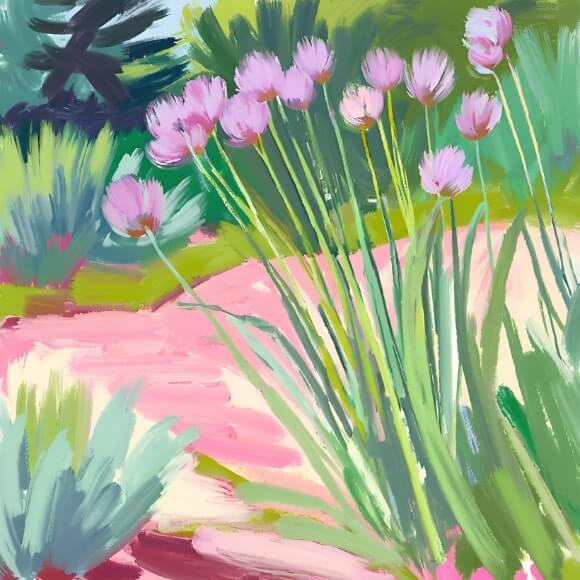Chives (Allium schoenoprasum) are a hardy perennial herb known for their mild onion flavor and delicate, grassy texture. As a member of the Allium family, which includes onions, garlic, and leeks, chives bring a gentle, onion-like taste to dishes without overpowering other flavors. These slender, tubular green stalks are often used as a garnish, adding a pop of color and a subtle aroma to culinary creations. In addition to their culinary uses, chives are also popular for their beautiful purple blossoms, which attract pollinators and add ornamental value to gardens.

Soil Requirements
Chives thrive in well-draining, moderately fertile soil with a neutral to slightly acidic pH level, ideally between 6.0 and 7.0. While they can tolerate a range of soil types, amending the soil with compost or organic matter can help improve their growth and flavor. Chives prefer soil that retains moisture but drains well, so avoid heavy clay or overly sandy soils.
Sun Requirements
Chives perform best in full sun, needing at least six hours of direct sunlight per day to produce lush, flavorful foliage. In regions with very hot Summers, chives can tolerate some light afternoon shade, which helps prevent the plants from wilting or drying out. If grown indoors, put chives near a bright window or under a grow light to ensure they receive enough light.
Watering Requirements
Chives appreciate consistent moisture but do not like waterlogged soil. Water the plants deeply, allowing the soil to dry out slightly between waterings. In general, a weekly watering is sufficient, but during dry or hot periods, additional watering may be needed. Mulching around the base of the plant can help retain moisture and prevent weeds, keeping the chives healthy and productive.
Best Plant Hardiness Zones
Chives are hardy in USDA Zones 3 to 9, making them adaptable to a wide range of climates. They are particularly resilient in colder zones and can survive harsh Winters, dying back to the ground and regrowing in the Spring. In warmer zones, chives may stay evergreen, providing a year-round harvest if protected from extreme heat.
Popular Chive Varieties
Chives are a popular and versatile herb that comes in several unique varieties, each with its own flavor profile, appearance, and culinary uses. From classic onion-flavored chives to varieties with a garlicky twist, there’s a chive for every taste and recipe. Here are five popular chive varieties and how to use them in your cooking.
Common Chives
Common chives are the most widely recognized variety, known for their mild onion flavor and vibrant green, tubular stems. These chives are the go-to choice for a subtle hint of onion, adding a fresh taste and beautiful green color to a variety of dishes.
Common chives are versatile and work well as a garnish for baked potatoes, soups, scrambled eggs, and salads. Their delicate flavor is best enjoyed fresh, so add them at the end of cooking or sprinkle them over finished dishes. They’re also perfect for making herb butter or chive-infused vinegar, adding a mild onion essence to homemade condiments.
Garlic Chives
Garlic chives, also known as Chinese chives, have flat, grass-like leaves and a distinct garlic flavor. These chives are slightly more robust than common chives and are often used in Asian cuisine. In late Summer, garlic chives produce white blossoms that are also edible and add a mild garlic flavor to dishes.
Garlic chives are ideal for dishes where a touch of garlic is desired, such as stir-fries, dumplings, and sauces. Their flavor holds up well in cooking, making them a great addition to savory dishes like fried rice or noodle soups. The leaves, stems, and flowers can all be used to add a subtle garlic taste without overpowering the dish.
Siberian Chives
Siberian chives are a hardy, cold-tolerant variety with blue-green leaves and a slightly more pungent taste than common chives. Native to colder climates, Siberian chives are resilient and can survive frost and low temperatures, making them an excellent choice for gardeners in cooler regions.
Siberian chives are ideal for hearty soups, stews, and baked dishes where their stronger flavor can add depth. They’re also wonderful in omelets, quiches, and casseroles, bringing a rich, oniony taste to warm, comfort foods. The leaves can be used fresh or dried for later use, as they retain their flavor well.
Giant Siberian Chives
Giant Siberian chives are a larger, more robust version of Siberian chives. They produce thicker stalks and have a bolder flavor, which is slightly spicier than other chive varieties. This variety is both decorative and edible, with purple-pink flowers that attract pollinators.
Giant Siberian chives are perfect for recipes that call for a strong onion flavor. They can be used in sauces, marinades, and dressings, or as a garnish for grilled meats and vegetables. Their large leaves make them easy to chop and add to dishes, and their sturdy texture holds up well in cooking. Try them in savory tarts or sprinkle them over roasted vegetables for an extra kick.
Blue Chives
Blue chives are known for their unique blue or lavender flowers and slightly milder flavor. While they’re often grown for ornamental purposes, blue chives are also edible and bring a subtle onion taste to dishes. Their delicate flowers are particularly attractive in the garden and can be used as a garnish.
Blue chives are best used as a garnish in fresh salads, sandwiches, and cold dishes, where their mild flavor can be appreciated. They’re also beautiful when used to top appetizers, adding color and a hint of onion without overpowering other flavors. ❖


 Previous
Previous

